All sorts of animals can be seen in the Great Barrier Reef. Other than providing a habitat for the marine creatures, the Great Barrier Reef is also a famous tourist attraction.
People from all over the world come to the reef to see the marine creatures. A popular marine creature to see is the jellyfish. There are many species of jellyfish to see. Here are the 17 Types of Jellyfish in the Great Barrier Reef. Below are some information on some of the features that jellyfish have.
Read more:
- Types of Jellyfish in the Atlantic Ocean
- Types of Stingrays in the Great Barrier Reef
- Types of Dolphins in the Great Barrier Reef
1. Box Jellyfish
 The Box jellyfish is a large species of jellyfish in the Great Barrier Reef. The body of this jellyfish resembles a box.
The Box jellyfish is a large species of jellyfish in the Great Barrier Reef. The body of this jellyfish resembles a box.
Moreover, the Box jellyfish has around 15 tentacles attached to its body. These tentacles are extremely long as they are able to reach 3 metres in length.
The Box jellyfish has a venomous sting. It leaves a terrible burning sensation to the victims.
Not only that, the sting will also leave a mark. The victim may lose the ability to breathe and eventually lose consciousness.
2. Irukandji Jellyfish
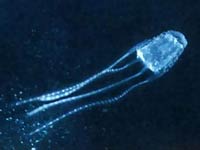 The Irukandji jellyfish is extremely tiny in size. But do not let its size give an impression of being harmless.
The Irukandji jellyfish is extremely tiny in size. But do not let its size give an impression of being harmless.
This type of jellyfish contains cells that could sting. The dangerous cells are located in their tentacles.
The cells release toxin to the jellyfish’s prey or humans who are swimming in water. Once the toxin gets to the target, the victim will experience paralysis.
The Irukandji jellyfish can be quite hard to see since it is small. Also, it has a transparent body.
3. Australia Sea Wasp
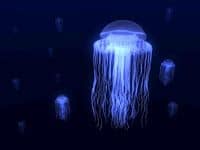 The Australia Sea Wasp is also a type of jellyfish found in the Great Barrier Reef. It’s a giant jellyfish with a lot of tentacles.
The Australia Sea Wasp is also a type of jellyfish found in the Great Barrier Reef. It’s a giant jellyfish with a lot of tentacles.
A mature species of this jellyfish can have as much as 15 tentacles on the body. The length of the tentacles could be around 3 metres long.
The Australia Sea Wasp can also sting. Reportedly, this huge creature actually has eyes. However, there is no sign of brain present in its body.
Read more: Types of Seaweed in the Great Barrier Reef
4. Net Jellyfish
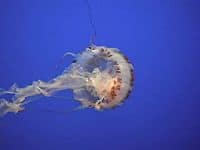 The Net jellyfish is shaped like a round bell. The reason why it is called a Net jellyfish is because of the pattern of its body.
The Net jellyfish is shaped like a round bell. The reason why it is called a Net jellyfish is because of the pattern of its body.
When carefully observed, there are dark lines of red going across its body, making a pattern of net. Other than that, this particular species of jellyfish do not have tentacles like the other kinds of jellyfish.
The Net jellyfish only has an arm. The colour of its arm is usually bright purple or red.
5. The Lion’s Mane Jellyfish
 The Lion’s Mane jellyfish is the world’s largest jellyfish. This type of jellyfish has a diameter of around 2 metres or even more.
The Lion’s Mane jellyfish is the world’s largest jellyfish. This type of jellyfish has a diameter of around 2 metres or even more.
It is shaped like a bell with long tentacles. The tentacles of the Lion’s Mane jellyfish are able to reach up to 50 centimetres in length.
Giant sized Lion’s Mane can have tentacles that are over 30 metres long. The colour of big Lion’s Mane is usually dark purple while the smaller species is often light orange.
Also read: Types of Starfish in the Great Barrier Reef
6. Bluebottle Jellyfish
 The Bluebottle jellyfish can also be found in the Great Barrier Reef. It’s a huge jellyfish with a single tentacle.
The Bluebottle jellyfish can also be found in the Great Barrier Reef. It’s a huge jellyfish with a single tentacle.
The tentacle can measure up to 1 metre long. The Bluebottle jellyfish is notoriously known to sting humans. There are thousands reports of jellyfish stinging humans each year.
Its venomous tentacle may cause a very painful sting. It can be a dangerous situation when the tentacle is detached from its body since the tentacle contains venom. The detached tentacle is able to survive for days in floating water.
7. Bonaire Banded Box Jellyfish
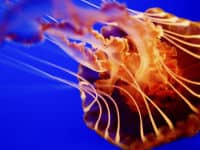 The Bonaire Banded Box jellyfish also goes by the name of Fire jellyfish. The shape of this jellyfish is boxy, similar to that of a plastic bag.
The Bonaire Banded Box jellyfish also goes by the name of Fire jellyfish. The shape of this jellyfish is boxy, similar to that of a plastic bag.
The tentacles of this type of jellyfish vary in colour. They might be bright orange, red or dark shade of brown.
Additionally, its tentacles also contain dangerous venom. People who got sting by this species usually end up with skin damage. Moreover, the sting caused by the jellyfish may feel extremely painful.
8. Blubber Jellyfish
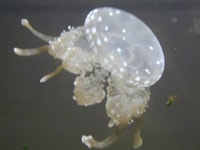 The Blubber jellyfish is a uniquely shaped jellyfish. This type of jellyfish is recognisable through its resemblance to the shape of a mushroom.
The Blubber jellyfish is a uniquely shaped jellyfish. This type of jellyfish is recognisable through its resemblance to the shape of a mushroom.
There are also frills surrounding the base of its body. The colour of the Blubber jellyfish could be brown or white.
This particular species produces its own body colour. Another interesting feature is the small openings on its arms that are used as entries for food. This jellyfish also sting but the sting do not cause any major harms.
9. Brown Jellyfish
 The Brown jellyfish is a large jellyfish. Its body resembles the shape of a saucer.
The Brown jellyfish is a large jellyfish. Its body resembles the shape of a saucer.
Besides being brown in pigmentation, this jellyfish also has white spots all over its body. The colour of this species is affected by an alga that lives inside its body tissues.
The Brown jellyfish has many long tentacles. Moreover, it also has a moth. Sometimes many species of Brown jellyfish gather over a surface area of the water. The sting caused by the Brown jellyfish does not cause pain.
Also read: Endangered Animals in the Great Barrier Reef
10. Moon Jellyfish
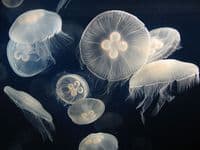 The Moon jellyfish is another type of jellyfish that can be seen within the waters of the Great Barrier Reef. The body of this jellyfish is transparent with a slight shade of pink.
The Moon jellyfish is another type of jellyfish that can be seen within the waters of the Great Barrier Reef. The body of this jellyfish is transparent with a slight shade of pink.
The average size of the Moon jellyfish is a medium one. The Moon jellyfish has a lot of tentacles. These tentacles hang loose from its body.
It also has sensors on its body that helps the jellyfish to move around the water. The Moon jellyfish is often carried away to land by water currents.
11. Australian Spotted Jellyfish
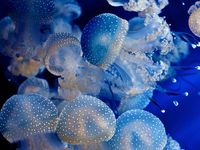 The Australian Spotted jellyfish prefers to live in the warm areas of the water in the Great Barrier Reef. However, the water must not have low salinity.
The Australian Spotted jellyfish prefers to live in the warm areas of the water in the Great Barrier Reef. However, the water must not have low salinity.
The Australian Spotted jellyfish resembles a mushroom too but with spots. There are huge frills under its body. Moreover, there are also quite a number of tentacles.
The Australian Spotted jellyfish has venom in the tentacles. But the venom is not dangerous. The pain caused from the sting is mild and usually treated with vinegar.
Read more: Endangered Species in the Great Barrier Reef
12. Cannonball Jellyfish
 The Cannonball jellyfish has a very dome shape. The body of this jellyfish species is transparent.
The Cannonball jellyfish has a very dome shape. The body of this jellyfish species is transparent.
But, the edge of its body is usually dark brown. The Cannonball jellyfish also has arms. The arms help it to swim and also to catch food.
The Cannonball jellyfish may release a life-threatening toxin. The toxin is meant to scare predators.
However, if the toxin ever comes in contact with humans then it may cause cardiac arrest as well as unbearable pain.
Also read: Threats to the Great Barrier Reef
13. Blue Jellyfish
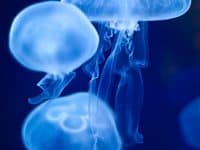 The Blue jellyfish is also known as the Bluefire jellyfish. The jellyfish is an average-sized jellyfish.
The Blue jellyfish is also known as the Bluefire jellyfish. The jellyfish is an average-sized jellyfish.
It rarely grows up to a large size for some reason. The most common colour for this species is deep blue.
Despite its name, however, some species may actually have light yellow pigmentation. This particular jellyfish has arms that are thick.
There are wrinkles and rough lines all over the arms. Moreover, the Blue jellyfish has plenty of tentacles that are ready to sting.
14. Immortal Jellyfish
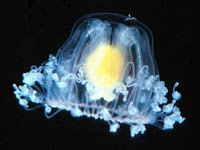 The Immortal jellyfish can also be seen in the Great Barrier Reef. This type of jellyfish is not that big in size.
The Immortal jellyfish can also be seen in the Great Barrier Reef. This type of jellyfish is not that big in size.
The shape of its body is the common bell, similar to the other species of jellyfish. The difference lies in the build of its body though.
The wall of its body is quite thin. Even though this creature is a small one, it has one huge stomach. The stomach is red in colour. Additionally, the Immortal jellyfish also has up to 90 tentacles.
Read: Conservation of the Great Barrier Reef
15. Mauve Stinger Jellyfish
 The Mauve Stinger jellyfish has an incredible ability that separates it from the other species. This jellyfish can illuminate itself in the dark.
The Mauve Stinger jellyfish has an incredible ability that separates it from the other species. This jellyfish can illuminate itself in the dark.
The colour of the Mauve Stinger jellyfish is usually a light purple, almost like lavender. Other species may also come in bright orange.
The Mauve Stinger jellyfish has arms that help it to feed on marine organisms. This species of jellyfish could turn dangerous. It may release poisonous toxin through the tentacles.
Read more: Threats to Aquatic Biodiversity
16. Pacific Sea Nettle Jellyfish
 The Pacific Sea Nettle jellyfish also swims in the water of the reef. The colour of this jellyfish is commonly brown with a slight shade of gold.
The Pacific Sea Nettle jellyfish also swims in the water of the reef. The colour of this jellyfish is commonly brown with a slight shade of gold.
Its size is quite huge. The jellyfish also has a lot of tentacles. This jellyfish is unable to go after prey.
Thus, it eats marine organisms as it swims through water. It spreads out the tentacles, turning them into a net.
The tentacles paralyse marine organisms. This jellyfish sting is harmless to humans.
17. Black Jellyfish
 The Black jellyfish is a huge kind of jellyfish. Just like its name, the colour of this jellyfish is a dark shade of purple that is very much close to black.
The Black jellyfish is a huge kind of jellyfish. Just like its name, the colour of this jellyfish is a dark shade of purple that is very much close to black.
Additionally, the black sea has around 8 tentacles in total. It also has arms. The sting of the Black jellyfish is toxic.
It’s harmful to its prey, causing paralysis. The same does not apply to humans. When a human gets sting by this jellyfish, it only cause pain for around 30 minutes.
Read more:
Jellyfish is a beautiful creature. All these types of jellyfish in the Great Barrier Reef have unique appearances. Despite all of their wonderful features, one should always be careful to not get sting by these creatures.